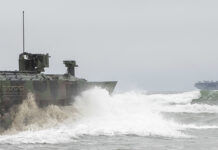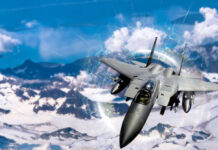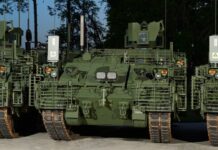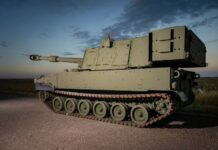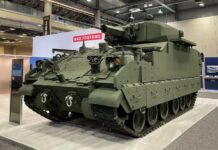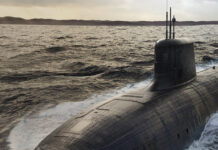Medium weight armoured fighting vehicles (AFV) are equipped with a broad choice of primary weapons, ranging from 20mm autocannons to full-bore 120mm guns. Overall, modern AFVs – whether light tanks, infantry fighting vehicles (IFV), or armoured reconnaissance vehicles – are trending towards more powerful weapons than previous vehicle generations.
The primary reason for this trend is that they must contend with a more diverse set of opponent vehicles and threats, as well as with improved armour on enemy vehicles. For this same reason AFVs are also mounting additional weaponry including anti-tank guided missiles (ATGM) and air defence weaponry suitable against helicopters and unmanned aerial vehicles (UAV).
A wide variety of turret systems are available as weapon and sensor platforms. Given the wide range of user requirements, flexibility has become a major consideration in the development of modern turrets. This includes the ability of a single turret to accommodate a variety of gun calibres. In addition to weapons, various cameras and sensors, including thermal imaging system and the targeting system, are integrated with the turrets. Both traditional manned turret configurations and unmanned/automated turrets which permit gun crews to remain in the main vehicle compartment are available. This article will discuss turret options for wheeled 8×8 AFVs.
GDLS LAV II/LAV III/LAV VI

The majority of 8×8 turrets are designed for autocannons in the 20mm to 50mm range. The General Dynamics Land Systems (GDLS) Light Armoured Vehicle III serving with the Canadian land forces and four other armies is typical in this respect. The turret employed on the LAV III and its predecessor the LAV II features a 25mm M242 Bushmaster 25mm chaingun as the primary weapon, with a coaxial 7.62mm machine gun and a second machine gun pintle-mounted atop the turret. Smoke grenade launchers are mounted on both sides of the turret. Chaingun ammunition is stored in bins inside the turret. Turret hydraulics were replaced with an electric turret drive system during an initial upgrade. Currently, the Canadian LAV III is being upgraded again, this time to the LAV VI standard. This will include another turret upgrade with advanced electronics, fire control systems, visual sensors and crew displays to improve target acquisition and weapon accuracy. Ergonomics and safety for the two-person turret crew are also being improved. The upgraded LAV is expected to stay in Canadian service through 2035.
The LAV-25, the immediate predecessor of the LAV III, is also utilised by the US Marine Corps (USMC) in various configurations including the LAV-AT (Anti-Tank) variant. A new turret was introduced on the LV-AT in 2017. Produced by Raytheon, this unmanned turret mounts two TOW tube-launched, optically tracked, wireless-guided ATGMs and the associated targeting and tracking sensors. Unlike its predecessor, the new turret is unmanned. The USMC cites numerous advantages, including greater crew safety; improved maintainability; and greater accuracy. The new turret deploys both wire-guided and radio frequency TOW missiles. The improved thermal sight can acquire targets while the LAV is in motion. Additionally, the new turret is equipped with a Far Target Location system, new commander/gunner video sight displays, and an electric elevation and azimuth drive system which helps rotate the weapon system onto the target.
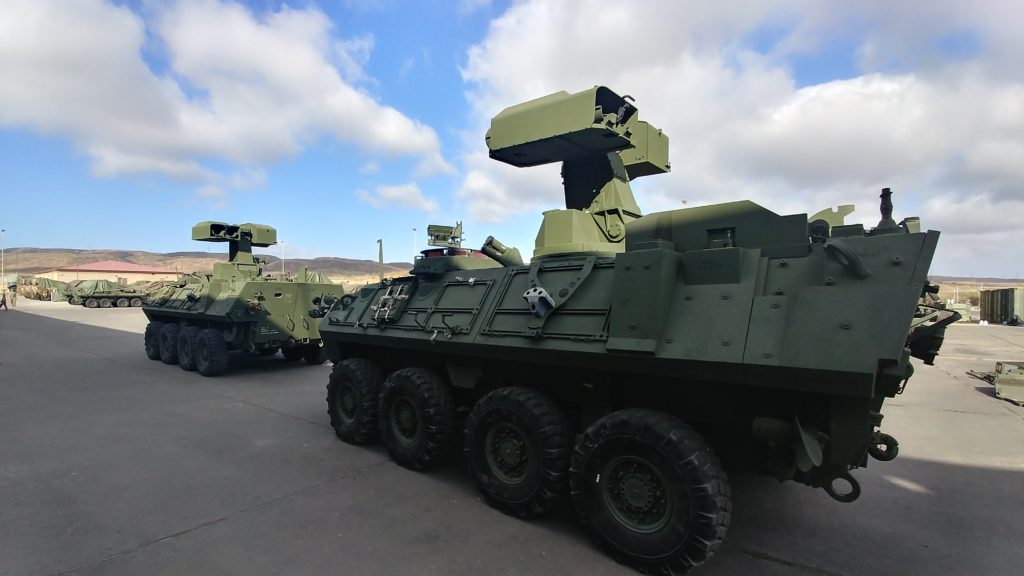
Kongsberg MCT-30

In 2015, the US Army decided to upgrade a portion of the STRYKER Infantry Carrier Vehicle (ICV) fleet with a 30mm automatic cannon. The first STRYKER DRAGOON equipped with the Kongsberg Protector MCT-30 turret was delivered to the US Army in Europe in December 2017. The MCT (Medium Calibre Turret) as incorporated on the STRYKER carries a 30mm Mk 44 BUSHMASTER chaingun, but the Norwegian-designed turret is capable of also mounting a 40mm automatic cannon. In addition to the main gun, the turret mounts a coaxial 7.62 machine gun and a roof-mounted second machine gun. Alternately to the roof-mounted MG, the PROTECTOR MCT can be equipped with a secondary remote weapon station (RWS) such as the Kongsberg PROTECTOR CROWS. Optional supplementary armament includes JAVELIN ATGMs mounted either on the CROWS or coaxially on the turret’s side. Two banks of four smoke grenade launcher tubes each can be optionally mounted on the turret. Turret mounted sensors include daylight and infrared cameras and a laser range finder with a target identification range in excess of 3,000 metres.
The unmanned turret is fully stabilised, including point stabilisation. It is capable of 360-degree rotation in azimuth -10 to + 45 degrees, and elevation up to + 60 degrees, making the gun effective against ground and aerial targets including UAVs. Both the vehicle commander and gunner are stationed within the vehicle hull, and operate the turret from a special control panel. A commander’s independent weapon station is optional. Reloading the turret’s automated munitions handling system is also performed under armour from within the hull (the turret includes storage for 600 rounds of 30mm munitions, in addition to 2x 75 rounds for immediate weapons feed). Soldiers note some loss of visual field outside the vehicle, as there is no turret hatch, but crew safety is considerably increased. The 30mm gun is remotely aimed and fired from within the vehicle proper.
Vectronics are modular, permitting customers to either retain the fire control and target acquisition sensors supplied by Kongsberg, or install alternate systems of their choice. The fire control system automatically performs ballistic computation compensating for the lead angle, cant, tilt and vehicle motion, making targeting easier in the most challenging scenarios. In addition, the turret is equipped with the Kongsberg Integrated Combat Solution (ICS), which allows it to gain access to a number of enhanced lethality features like automated precision Hunter-Killer, and target sharing between vehicles.
The standard turret comes with STANAG 1 level protection, which can be increased through modular armor on the front and sides. Soft-kill and hard-kill active protection systems are available as optional upgrades, as is a threat detection system. The turret adds approximately two tons to the STRYKER ICV’s weight.
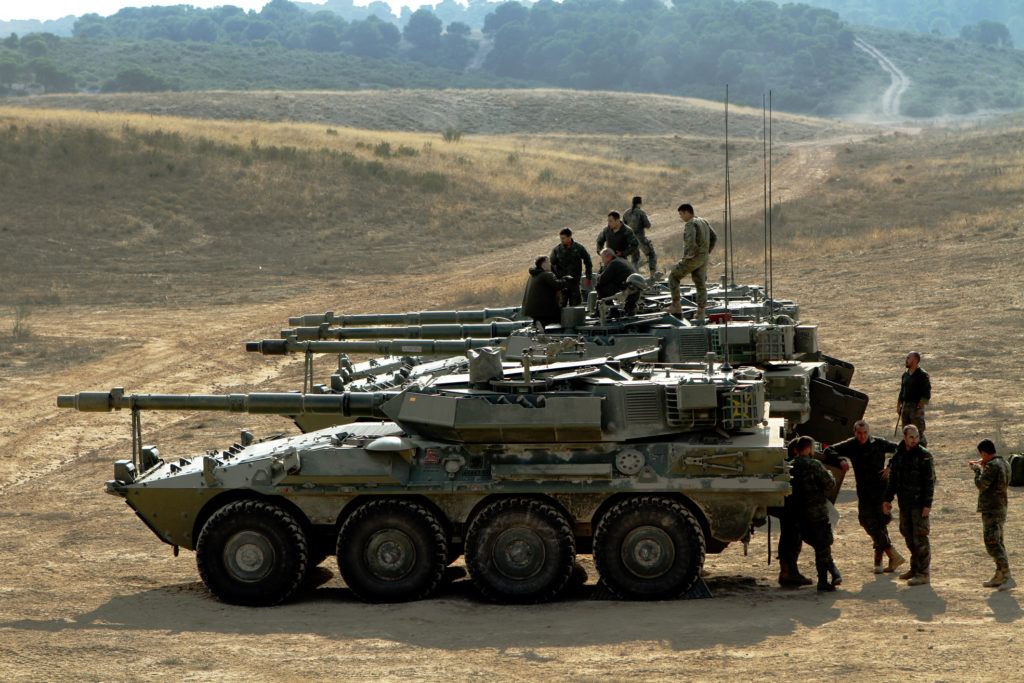
BAE Hägglund E35
The MCT-30 is also utilised on the Croatian army’s PATRIA AMV (armoured modular vehicle). However, most other versions of the PATRIA AMV are armed with the BAE Hägglund E35 turret which was originally designed for the Hägglund CV9035 tracked AFV. More than 600 of these turrets are in service with the land forces of six nations. The system was extensively proven in Afghanistan, where Danish and other forces praised the turrets responsiveness, accuracy and lethality. The E35 has demonstrated precision fire beyond 4,000 metres engagement range.

The manned E35 turret has side by side seating for the vehicle commander and gunner, with the breach of the cannon positioned between the two. This places the weapon’s centre of gravity centrally inside the E35’s turret ring, maximising stability for the vehicle and for the firing process. The two tonne turret is designed with a fully digital architecture, and mounts a 35mm Bushmaster III autocannon. Two 35 round belts with different ammunition options are simultaneously loaded, while an additional 140 rounds are stored on board. The advanced fire control system developed by SAAB provides the commander with an independent panoramic sight with day and night vision modes. When a target is detected the turret automatically slews into a firing position, while the gunner assumes responsibility for the final aiming and firing process. While the gunner engages the selected target, the commander is already searching for the next opponent. This hunter-killer mode is customary on latest generation MBTs, but still uncommon on IFVs.
Leonardo HitFact

Leonardo Defense Systems (formerly OTO Melara) produces two turrets suitable for different vehicle types. Both turrets are designed to support large bore weapons.
The HitFact Mk 2 medium turret provides near-MBT (Main Battle Tank) quality striking power to light tanks and to tracked or wheeled medium AFVs such as tank destroyers. It accommodates both 105mm and 120mm low recoil guns. Secondary armament include a coaxial 7.72mm NG and either a pintle-mounted second MG or the HITROLE Light RWS. The turret itself is smaller than that of an MBT, scaled to the requirements and capacity of medium-sized wheeled vehicles. It is composed of ballistic aluminium, steel plates and composite materials to reduce weight while providing protection equal to that of heavier turrets. Mounting low-recoil guns permit firing on the move without endangering vehicle stability or excessively stressing vehicle frame integrity.
The Mk 2 is the second generation of the HitFact family. The original Hitfact was the first low-recoil turret capable of providing 120mm MBT-equivalent firepower on an 8×8 wheeled AFV. The common modular gun mount enables rapid field reconfiguration between either cannon. The gun’s recoil is minimised through the combined action of the hydraulic recoil/counter-recoil system and the integrated, high-efficiency muzzle brake.
More than 500 HitFact turrets are in service with the armed forces of Italy and other nations. The Mk 2 incorporates lessons learned from real-world operations with the original turret.
The electric servo-driven HitFact turret can accommodate a two- or three-person crew, and includes the option of an automated munitions loading system. Commander and gunner stations are connected to stabilised electro-optical day and night sights for targeting and for battlefield surveillance; a mechanically-linked periscope system as backup for the electro-optical systems can be accessed from within the turret. Munitions for the primary and secondary weapons are housed in a separate compartment at the rear of the turret to protect the crew from the effects of deflagration. Turret ergonomics, including blast mitigating seating, are optimised for crew survival. An automated fire-extinguishing and anti-explosion system is standard.
The HitFact Mk 2 is designed to maximise flexibility. The turret can be mounted on a variety of chassis. The open electronic architecture design allows end-users to choose from different types of electronics, sensor suites, communications, and secondary weapons to produce a customised weapon system.
Leonardo HitFist
Leonardo’s HitFist light turret is designed specifically for infantry fighting vehicles. It can accommodate either a 25mm Oerlikon KBA or 30/40mm ATK Mk 44 main gun. Additional armament includes a coaxial 7.62 MG, a second pintle mounted MG, and an optional mount for two ATGMs at the side of the turret. The armoured turret has a low silhouette and features enhanced ballistic protection.
The latest generation HitFist III is two-person power-operated turret is equipped with state-of-the-art vectronics including man-machine interface systems to maximise efficiency. The gun is electrically controlled for elevation, azimuth, and tracking. The gun elevation arc ranges from -10 to +60 degrees, with a 360-degree training arc for the turret. The fully digital servo systems ensure stabilisation and a high degree of accuracy when firing. The side-by-side commander’s and gunner’s stations are both equipped with LCD colour displays. The fire control system is wedded to a self-stabilised optical sight for day and night and a Commander Panoramic Sight with daylight and infrared television cameras, providing the crew with situational awareness and full hunter capability modules. When necessary, one person can operate the turret alone.
Leonardo has also introduced an unmanned variant designated the HitFist OWS (Overhead Weapon System). Leonardo describes the new turret as a remotely operated weapon station developed with the latest technologies in the field of electronics, signature and Man Machine Interface. The main armament consists of the 30mm chain gun, electrically controlled in elevation, traversing and firing operations. The new turret has the advantage of being mounted on any wheeled or tracked vehicle without special preparation and without penetration of the hull. For now, it has been mounted on the newly developed 8×8 CENTAURO Armoured Infantry Fighting Vehicle FRECCIA presented by Iveco-OtoMelara. It is armed with either a 25mm or 30mm chain gun, with a 7.62 coaxial MG and side-mounted ATGMs being optional. The turret includes optical sensors and a laser rangefinder, and provides both 360-degree situational awareness as well as full hunter capability modules. The weapon can be controlled by a single soldier from within the vehicle hull utilising a multifunction colour display and a joystick. The turret can be accessed for reloading and maintenance through adjacent hatches in the vehicle roof and the turret floor.
Rheinmetall LANCE
Rheinmetall produces the LANCE turret in two variants, manned and unmanned (LANCE RC – Remote Controlled). The LANCE system ranks among the most modern and modular turrets available today. The turrets and their associated weapons can be mounted on virtually any tracked or wheeled vehicle.
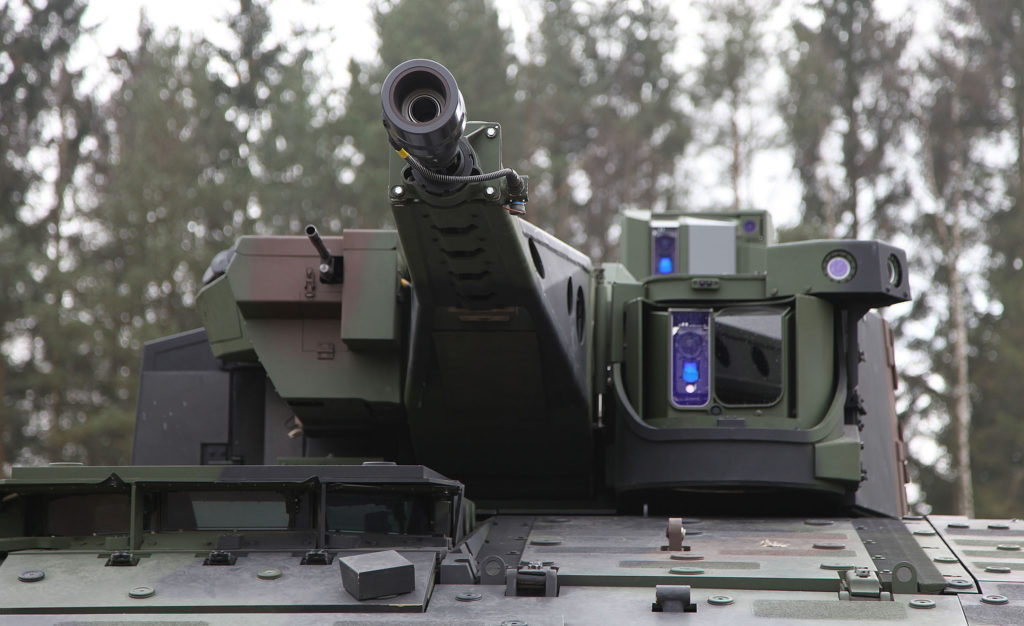
The manned LANCE turret is mounted on Rheinmetall’s BOXER AFV which is deployed with the German army and several other land forces. The two-person crew consist of the vehicle commander and the gunner. The primary weapon deployed here is Rheinmetall’s Mk 30-2/ABM automatic cannon, although other guns – including those made by different manufacturers – can be installed on the turret. In addition to the actively loaded munitions, an additional 200 rounds of reserve ammunition for the main gun are carried within the turret, enabling reloading under armour. The turret enjoys a high degree of protection against blast, fragmentation and even RPG fire; modular add-on armour is available to further increase the level of protection.
Both the manned and RC versions of the LANCE turret are fully stabilised, permitting accurate fire while moving through rough terrain. Each variant is outfitted with a state-of-the-art, fully digital fire control system. External sensors include two electro-optical sights, each equipped with a high-resolution camera, a thermal imaging camera, and a laser rangefinder. One of the sights enables 360-degree visibility, irrespective of the movement of the turret. All turret systems can be operated by both the commander or the gunner, whether from inside the turret or – with the RC variant – from within the vehicle hull.
A wide range of optional equipment can be integrated onto the LANCE turret. These include a situational awareness system (SAS), an independent weapons station mounted atop the turret, C4I systems for network-enabled operations , and an additional sight for the commanding officer. Rheinmetall stresses the modular approach to the LANCE design which aims to ease integration of future hardware to keep the turret at the cutting edge of technology and capabilities throughout the vehicle’s lifetime.
Nexter Turrets
French company Nexter offers a wide range of turret solutions mounting weapons between 25mm and 105mm. The DRAGAR, originally developed by GIAT, is armed with the 25mm Nexter Systems 25 mm Model 811 dual-feed cannon and a coaxial 7.62mm MG. The two-tonne turret is suitable for smaller and lighter wheeled IFVs, providing 50% more firepower than a 20mm-armed turret but without impacting manoeuvrability. The turret is all electric, with no hydraulic components. The turret’s modular design has enabled Nexter to regularly upgrade the DRAGAR with new vectronics and auxiliary systems including defensive systems, battlefield IFF, and the FINDERS battlefield management system. The gunner’s sights are also displayed on the vehicle commander’s station which is located inside the hull; an override switch allows the commander to direct and fire weapons from his station if the gunner is incapacitated.
The TARASK turret, a derivative of the DRAGAR, was selected for the French Army’s 8×8 VBCI ((Véhicule Blindé de Combat d’Infanterie – Armoured IFV) which entered service in 2008.The single-seat TARASK provides the gunner with day and night cameras for target acquisition as well as a series of episcopes placed around the turret to provide 360-degree situational awareness. The vehicle commander’s station inside the hull controls the Panoramic Observation Device (Moyen d’Observation Panoramique, MOP), a day/night observation sight allowing the commander to hunt for new targets or threats while the gunner engages the current target. The turret is also equipped with the LIRE (Leurre Infra RougE) infrared wire-guides missile jammer. The turret itself has a 360-degree traverse arc, while the gun barrel has a vertical arc of -7 to +45 degrees. The welded steel and aluminium turret is protected against small arms fire and artillery fragmentation; modular add-on armour is available.
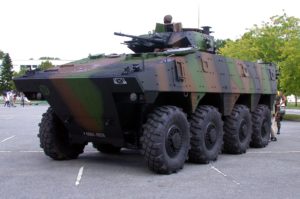
Nexter’s two-person T40 turret was selected for the VBCI 2, which is larger and heavier than the first generation VBCI. The T40 is armed with the 40CTAS (Case Telescoped Armament System) 40mm cannon developed by CTA International; it is considerably more powerful than the TARASK’s chaingun. The T40 turret is augmented by a roof-mounted remote weapon system equipped with either a 7.62mm or 12.7mm MG. Unlike the TARASK, this turret can also mount ATGMs on both sides. It is compatible with a variety of missile types. The gunner and commander receive situational awareness and targeting data through periscopes and video cameras mounted along the turret. The T40 also is outfitted with an on-board simulation capability and vectronic fire for training purposes. Overall, the open vectronic architecture ensures both scalability of the weapon systems capabilities, as well as the ability to continually upgrade with the newest components. Nexter also offers an unmanned variant of the T40.
Cockerill 3000
The wide range of potential threats has increased interest in modular turret systems which can be optimised for various and changing threat environments, from anti-tank warfare to urban operations and peacekeeping missions. This trend toward modularity includes manufacturers designing turrets capable of supporting a range of weapons on the same basic frame. John Cockerill Defense’s 3000 series turret is one of the most versatile, capable of accommodating anything from a 25mm autocannon to a 105mm high pressure direct fire gun. Up to four ATGMs can be carried on optional mounts at the sides of the turret. The 3000 series is available in manned (two-person crew) and unmanned configurations.
The basic turret provides full digital stabili-sation and computerised for accurate fire when stationary or moving. The welded ballistic aluminium turret can accept modular add-on armour which can increase protection up to STANAG level 5. Additional protective systems include eight smoke grenade launchers, APS, anti-sniper detection, and distributed acoustic sensing.
Sidney E. Dean is President of Transatlantic Euro-American Multimedia LLC. and a regular contributor to ESD.





